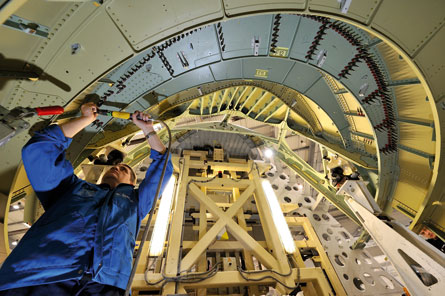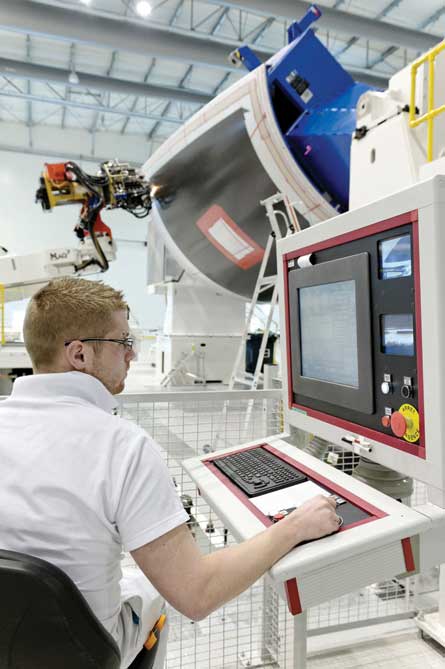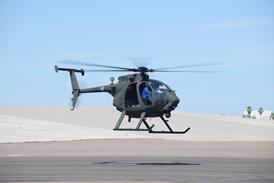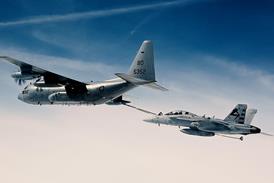EADS' France-based aerostructure subsidiary Aerolia plans to deliver the first two Airbus A350 cockpit fuselage sections this summer in continuation of the former Airbus operation's tradition to build the "front end" of the European aircraft family. However, the target for the company is to be sold to an external investor and to balance out its nearly exclusive Airbus workload against other manufacturers.
Production is running up in the new 18,000m² (194,000ft²) composite unit at Aerolia's assembly site in Méaulte, 30km (18 miles) northeast of Amiens, which opened at the end of November 2010, even though means of production were still being installed in late May. The first A350 nose fuselage section is to be delivered "between June and September", says chief executive Christian Cornille, adding that the second one is to follow "within a month".
Unlike the cockpit fuselage sections of previous Airbus models, which consist of a single lower shell to approximately floor level, Section 11 forming the upper structure immediately around the flight deck and Section 12 extending aft until just behind the first set of passenger doors, the A350 follows a different construction.
While the majority of the nose fuselage section will have a carbon reinforced plastic (CFRP) structure and panelling, Section 11 will be made of aluminium. Four composite panels will cover the remaining part of the fuselage frame structure: the nose upper shell extending aft from above the cockpit windows; left- and right-hand side panels including the respective passenger door apertures; and a single panel to cover the lower area of sections 11 and 12, which will be the largest of the four at approximately 30m².
 |
|---|
© Aerolia |
Assembly of a conventional metallic cockpit section |
All panels are manufactured in the new composite unit, which is divided into three main sections. The initial clean room comprises a single production line for the composite lay-up, inclusion of stringers and preparation for curing of all four panel types. The CFRP material is built up on the male mould from the inside out, starting with the innermost layer and ending with the "outer skin". The female mould is then lowered, with the material "sandwiched" in between the two moulds so that everything can be turned around. The male mould is removed and stringers are added on the now freely accessible inner panel side.
The next section includes a 7m (23ft)-diameter, 11m-long autoclave, which allows to "bake" up to two panels - still on their female moulds - at a maximum temperature of 180°C (356°F) and pressure of 7-8bar (101-116psi) during a 10-hour curing process. The panel is then removed from the mould and freed of the protective foil to prevent adhesion to the mould. Thereafter, the panels enter a combined high-pressure water jet cum five-axis machine tool to trim the edges, cut openings and drill holes.
The final section houses a buffer zone for production panels, a quality control area with non-destructive testing (NDT) equipment and tools for possible repairs, a paint booth and oven, as well as the final panel assembly with four production lines. The panels are vertically suspended and fixed in metallic crates for protection and to ensure they maintain their shape while being in the buffer zone or being transported. Also, the production stations have been set up for the staff to work on vertically fixed panels for better ergonomics.
Marrying the panels with the externally produced carbon airframe components and locally manufactured metallic Section 11 takes place in the existing assembly facility, in which the nose fuselage sections of other models are taking shape.
An intriguing detail of the composite unit is that its layout has not been devised on screen by computer-aided design but more playful, manual means. Around 10,000 Lego bricks have been employed to build the facility in 1:50 scale, complete with a workforce of square-footed toy builders, by a team of around 100 production staff members and designers over a two-year period.
The idea came from composite unit manager - and life-long enthusiast for the Danish plastic bricks - Olivier Canal, who sees a distinct advantage over virtual, CAD-based models. The fact that people can take the physical model into their hands and "play" with its functionality invites them to participate actively, he says, If the facility had been designed on screen, there would be one person operating the software and everyone else standing around having to imagine how the site works, he adds.
Aerolia has invested around €80 million ($115 million) in the composite unit at Méaulte and allocated approximately €200 million in total for the A350 programme. It is worth noting that Airbus decided to pursue a composite airframe structure for the new twinjet before divesting the Méaulte plant, its sister site in St Nazaire and the respective design office in Toulouse as part of the airframer's Power8 cost reduction programme, which led to the formation of Aerolia in 2009.
Although wholly owned by EADS, the company consequently had to source its own funding. Setting up the carbon operation was a "difficult and critical phase", says Cornille. "But for us it is impossible to be out of this programme [A350] In the same way we have to be on the brand new single-aisle programmes in Airbus or Boeing."
 |
|---|
© Aerolia |
Placing carbon-fibres for an A350 fusilage panel |
Aerolia generated revenues of around $1 billion in 2010 and expects this to grow by around 10% this year. Nearly all of its work is for Airbus, with 2-3% being for the French aerospace group Latécoère and Belgium-based Sonaca. However, by 2020 the Airbus work share is to form just half of Aerolia's work, while 25% is to come from Boeing and Sikorsky, and the remaining quarter is to be sourced from companies such as Bombardier, Dassault, Embraer, Eurocopter and Piaggio. Revenue is expected to hit $3 billion at the end of the decade.
Designing and building the Bombardier Global Express 7000 and 8000 centre fuselage, including tube and pipe equipment, which the company won last month, is a first step in this direction. Components will be manufactured across the French facilities and a subassembly production complex in Tunis, which Aerolia has been setting up with partners since 2009, but final assembly will take place at a new plant in Canada. Service entry for two large business jets is planned for 2016-2017.
Cornille says he is in discussions with another business aircraft and a helicopter manufacturer and that a decision is expected "probably in the third quarter 2011". He wants the company to become involved across the aerospace industry in helicopter, military, business, and large and regional commercial aircraft programmes in future. "Boeing is the key target for us in the future," he says.
As the US airframer is unlikely to subcontract work directly to an EADS subsidiary, "in the future" means after Aerolia's planned sale to an external investor. Cornille sees the company on "quite the same road map" as Wichita-based Spirit AeroSystems, albeit at a slower, European pace.
In 2008, EADS was negotiating with Latécoère to acquire the business, but the sale fell through and what to do next was solved with the creation of Aerolia for the time being. However, the goal to divest the company remained on the long-term agenda. When asked what went wrong with the deal, Cornille responds that any buyer would need to be able to continue the operations and "in the case of Latécoère, at the end of the day, it was impossible".
However, even before Boeing can come on board as a customer, Aerolia has to demonstrate its ability to attract business from outside Airbus. That is one of three preconditions that the parent has set out for the sale. The other two are financial sustainability and technical competence to deliver products at the required standard under its own leadership.
"They [EADS] consider for the moment that we have some risk areas in which we have to improve," says Cornille. "Regarding the financial situation, we are on the right way." He calls the A350 programme the "last risk" and adds that "probably in 2011 we will be in a position to demonstrate to our shareholder that we are able to deliver what our customer Airbus requires."
Influence on this judgement is also likely to come from how well the company performs in the production ramp-up of the new twinjet. This is planned to happen in two steps: seven aircraft are to be manufactured each month in the first stage, and later this rate is to increase to 14. However, neither Aerolia nor Airbus wanted to put a timeline to this strategy.
"I think our shareholder is clearly not in an urgent mode but [wants] to work in a pragmatic way, looking at our capability and at opportunities in the market," says Cornille. The later point, finding a suitable buyer in today's market, might prove to be yet another hurdle.
Source: Flight International























